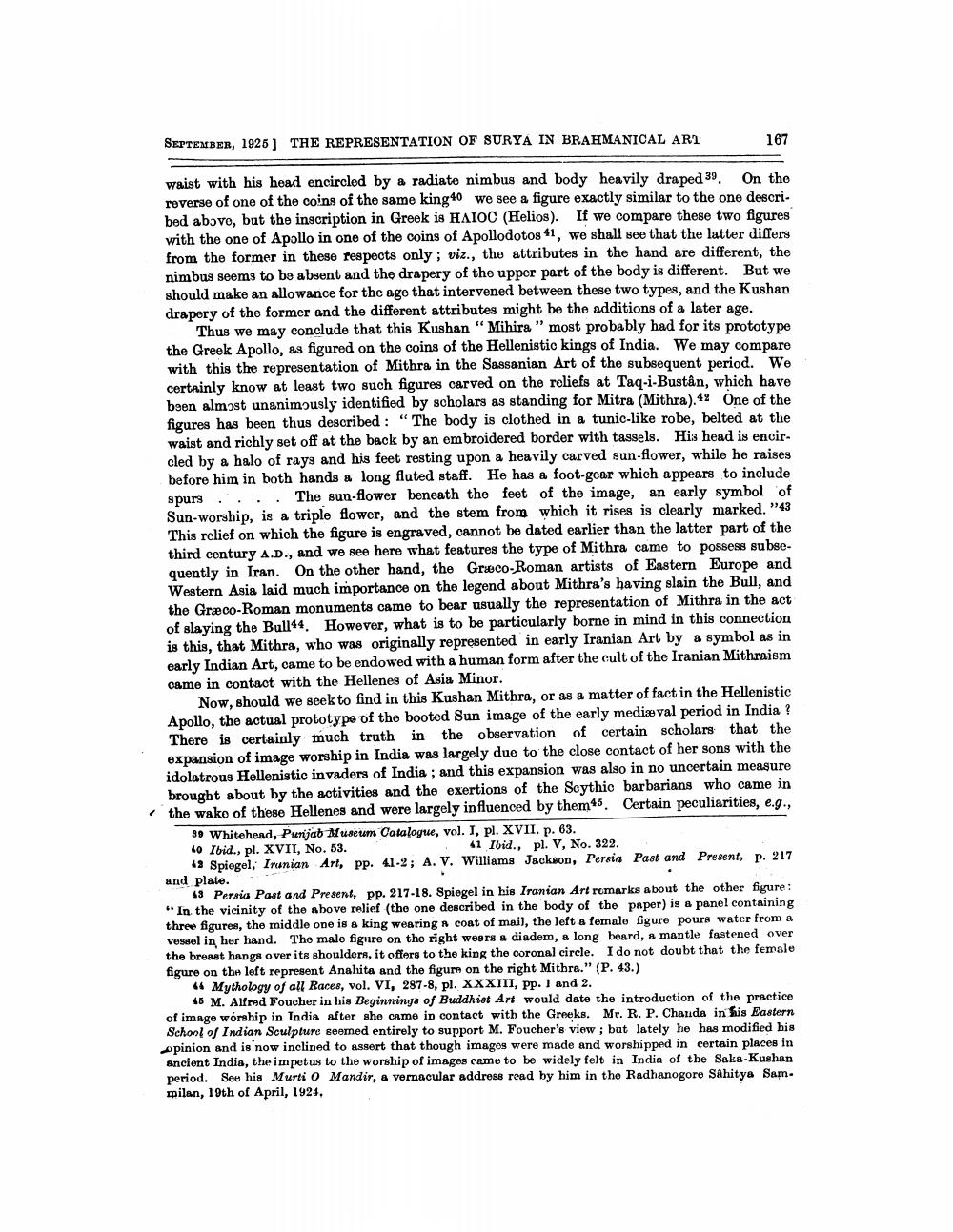________________
SEPTEMBER, 1926 ] THE REPRESENTATION OF SURYA IN BRAHMANICAL ART
167
waist with his head encircled by a radiate nimbus and body heavily draped 39. On the reverse of one of the coins of the same king40 we see a figure exactly similar to the one described above, but the inscription in Greek is HAIOC (Helios). If we compare these two figures with the one of Apollo in one of the coins of Apollodotos 41, we shall see that the latter differs from the former in these respects only; viz., the attributes in the hand are different, the nimbus seems to be absent and the drapery of the upper part of the body is different. But we should make an allowance for the age that intervened between these two types, and the Kushan drapery of the former and the different attributes might be the additions of a later age.
Thus we may conclude that this Kushan "Mihira " most probably had for its prototype the Greek Apollo, as figured on the coins of the Hellenistic kings of India. We may compare with this the representation of Mithra in the Sassanian Art of the subsequent period. We certainly know at least two such figures carved on the reliefs at Taq-i-Bustân, which have been almost unanimously identified by scholars as standing for Mitra (Mithra).42 One of the figures has been thus described : "The body is clothed in a tunic-like robe, belted at the waist and richly set off at the back by an embroidered border with tassels. His head is encircled by a halo of rays and his feet resting upon a heavily carved sunflower, while he raises before him in both hands a long fluted staff. He has a foot-gear which appears to include spurs ... The sun-flower beneath the feet of the image, an early symbol of Sun-worship, is a triple flower, and the stem from which it rises is clearly marked. "43 This relief on which the figure is engraved, cannot be dated earlier than the latter part of the third century A.D., and we see here what features the type of Mithra came to possess subsequently in Iran. On the other hand, the Greco-Roman artists of Eastern Europe and Western Asia laid much importance on the legend about Mithra's having slain the Bull, and the Græco-Roman monuments came to bear usually the representation of Mithra in the act of slaying the Bull44. However, what is to be particularly borne in mind in this connection is this, that Mithra, who was originally represented in early Iranian Art by a symbol as in early Indian Art, came to be endowed with a human form after the cult of the Iranian Mithraism came in contact with the Hellenes of Asia Minor.
Now, should we seek to find in this Kushan Mithra, or as a matter of fact in the Hellenistic Apollo, the actual prototype of the booted Sun image of the early mediæ val period in India ? There is certainly much truth in the observation of certain scholars that the expansion of image worship in India was largely due to the close contact of her sons with the idolatrous Hellenistic invaders of India, and this expansion was also in no uncertain measure brought about by the activities and the exertions of the Scythic barbarians who came in the wake of these Hellenes and were largely influenced by them*5. Certain peculiarities, e.g.,
39 Whitehead, Purijab Museum Catalogue, vol. I, pl. XVII. p. 63. 40 Ibid., pl. XVII, No. 53.
41 Ibid., pl. v, No. 322. 42 Spiegel, Irunian Art, pp. 41-2; A. V. Williams Jackson, Persia Past and Present, p. 217 and plate.
18 Persia Past and Present, pp. 217.18. Spiegel in his Iranian Art remarks about the other figure: ** In the vicinity of the above relief (the one described in the body of the paper) is a panel containing three figures, the middle one is a king wearing a coat of mail, the left a female figure pours water from a vessel in her hand. Tho malo figure on the right weers a diadem, a long beard, a mantle fastened over the breast hangs over its shoulders, it offers to the king the coronal circle. I do not doubt that the female figure on the left represent Anahita and the figure on the right Mithra." (P. 43.)
44 Mythology of all Races, vol. VI, 287-8, pl. XXXIII, pp. 1 and 2.
46 M. Alfred Foucher in his Beginnings of Buddhist Art would date the introduction of the practice of image worship in India after she came in contact with the Greeks. Mr. R. P. Chanda in his Eastern
School of Indian Sculpture seemed entirely to support M. Foucher's view ; but lately he has modified his opinion and is now inclined to assert that though images were made and worshipped in certain places in ancient India, the impetus to the worship of images came to be widely felt in India of the Saka-Kushan period. See his Murti 0 Mandir, a vernacular address read by him in the Radhanogore Sahitya Sam. mpilan, 19th of April, 1924.




